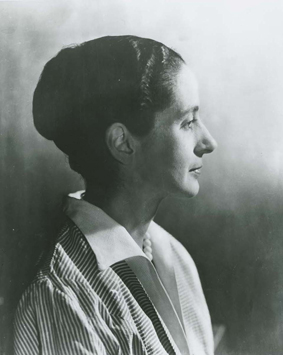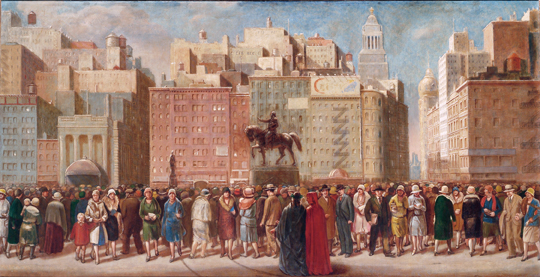Art Essay: Isabel Bishop’s New Vision: Social Mobility Beyond the Separate Spheres
 Isabel Bishop |
By Rena Tobey ©2015
ART TIMES Winter 2015
Isabel Bishop (1902-1988) developed her artistic voice during the Depression, when rigid gender roles and the Separate Sphere ideology were breaking down. She moved to New York at 16 to become a professional artist and made her reputation depicting an emerging sub-genre of the ‘New Woman’—the ‘Career Girl’ in the public sphere, specifically, the ‘Office Girl’ who worked at Union Square. During the Depression, Union Square blended office workers, the unemployed and homeless, social activists and soapbox orators, shoppers, and crowds gathered for political rallies. Bishop maintained a studio in various locations around the Square for fifty years. She watched the melee from her studio window and also mingled in the Square, sketchbook in hand. She, along with 3 male colleagues, including her teacher Kenneth Hayes Miller (1876-1952), became known as the ‘14th Street School’, named for one bordering street.
Coming from a poor family herself, Bishop had sympathy for the unemployed men who passed their days at the Square, as well as for the Office Girls. She depicted those young women with dignity, in their cheaply-made clothes, aspiring to the upward mobility of a white-collar position or socially-improving marriage. With four banks, insurance and electric companies, department stores, and many small organizations, Union Square businesses generated 10,000 clerical positions. These jobs served as a major source of employment for single and, increasingly, married women during the Depression. Although married women were criticized for taking jobs from men for miniscule pay, overall these wage-earners were considered exemplars of independent womanhood. Both single and married working women were often saviors of their families, when unemployment reached 25%, and many men could no longer find any kind of work. Rather than victims of poverty, the working woman became a symbol for women’s place in the larger world.
Isabel Bishop, “Young Woman”, 1937 Pennsylvania Academy of Fine Arts |
As with other occupations, as more women became clerical workers, men abandoned the positions, long an entry point for climbing the organizational ladder. With the invention of the typewriter, the work became more routinized and feminized, no longer offering a responsible starting point for a larger career.
But Bishop perceived these young women’s fate differently. She believed in upward social mobility, using imagery of the Office Girl to demonstrate that possibility. In the 1930s, she made a series of works focusing on young women at lunch time. She depicts them attired in “their cheap rayon dresses” (Bishop, in an oral history), who used their lunch hour to create a kind of domestic-sphere intimacy in the modern urban environment. They ignore the viewer, taking a respite from their pressured day and being “bossed around” by men at work.
Bishop also shows viewers how these young women just entering the workplace start to grow up. Now the Office Girl has been promoted, as seen in Young Woman from 1937. She displays polish, decorum, and grace, dressed in a tailored, smart business suit, boldly and assuredly striding forward into the public sphere. This is a woman with things to say and places to go, well beyond the domestic. She aspires to more, to bigger, to better, an equal in confidence and competence with any man.
Bishop demonstrated her own competence with her meticulous technique. Like her teacher Miller, she reflected her interest in Renaissance art by working in those traditional methods. She would not only make drawings prior to painting, but also took the extra step of working out her composition with prints. She used the rigorous, time-consuming process of painting with egg tempera, a method that lost prominence with the increased prevalence of oil paints beginning in the 17th century. With these techniques, Bishop worked slowly, often taking a year to finish one work.
A premier example of her Renaissance-inspired painting is Dante and Virgil in Union Square from about 1932. The hard times of the 1930s created a new egalitarian spirit, and Bishop reflects that energy in the painting, along with her own passionate and optimistic belief in the possibility of upward mobility. She fills the painting with classical references and Renaissance art imagery: the equestrian statue with the orator’s extended arm; skyscrapers with Ancient Greek temple motifs both at street level and rising into the sky; and classical architecture’s sculptural frieze decoration, now a horizontal band of bodies in action. But rather than depicting a mythological or historical setting typical of Old Masters’ paintings, this scene takes place in the contemporary world of Union Square.
Bishop creates a kind of charmed universe with the primary colors of red, blue, and yellow. For all the people crammed in this one place, the atmosphere is calm, achieved through the repeated use of vertical and horizontal lines. The backdrop of Union Square buildings, used in an arbitrary, not literal way, represents a stage set of the modern world, with its emblematic skyscrapers aspiring to new heights, yet rooted to the ground. The sage-green building topped by a billboard, just right of center, prominently features a zigzag fire escape. For Bishop, the ladder’s repeated plateaus and rising diagonals represent how anyone who works hard can reach new heights, her pictorial representation of upward social mobility. The buildings are geometric and strong, and together, they push all the figures forward to the front of the picture plane.
 Isabel Bishop. Dante and Virgil in Union Square, 1932. Oil on canvas, 27 x 51 3⁄4 inches. ©The Estate of Isabel Bishop. Courtesy of DC Moore Gallery, New York. Collection of the Delaware Art Museum, Gift of the Friends of Art, 1971. |
Humorously and oddly, the figures of Dante and Virgil, dressed in classical garb, are placed across the street, separated as outsiders from the central action in the Square. Bishop’s experience of the provocative Union Square tableau inspired her connection to “The Divine Comedy,” from 1320. In it, Virgil, as guide and mentor, travels with Dante through Purgatory and Hell. They have conversations about the multiplicity of human souls. In the painting, in their removed position, Dante and Virgil take in the people of modern-day New York. The viewer is placed behind them, even farther away, able to perceive the whole scene, this time, with Bishop as guide and mentor.
Hordes of anonymous people fill the Square, with the figures forming a band across the entire foreground of the painting. Bishop has made the front row a microcosm of types, people in motion, which, for her, represents their social mobility. On the far left, with their backs to the viewer are an immigrant woman in her long skirt and shapeless jacket, along with another figure carrying a baby. They head anonymously into the crowd to assimilate as Americans. Next to them, a smartly-dressed woman, in her cloche hat and fur-lined coat, holds the hand of a boy in an orange jacket and knee-length britches. They represent how the immigrants can emerge from their assimilation. To their right, a working-class man in cap and loose-fitting brown clothes faces the buildings and the equestrian statue, perhaps making his way to hear an orator stationed there. Other men, more nattily attired in three-piece suits and fedoras, both face toward the viewer and away. Middle-class women shoppers clutching packages mingle with young women working their way up in life. At the far right, a man with slightly stooped shoulders holds the arm of a younger woman, perhaps a father and daughter.
Seemingly static, the figures actually move in multiple directions and through varying walks of life. In Union Square, all types of people mix, merge, co-exist, and move among each other. Men and women, young and older, rich and poor provide souls for Dante and Virgil to contemplate, not in separate universes, but in one mass Purgatory of the Depression. The masses become individuals, purposefully moving this way and that, striving to elevate to a Heaven that is beyond economic and social despair.
The contrived, classical harmony in the painting is warmed with Bishop’s own empathy and aspirations for those she paints. For her, the Square was a place of beauty and potential, not the Hell of lost and doomed souls that the viewer might assume from the presence of Dante and Virgil. To reinforce Bishop’s optimism, the cityscape and people are bathed in sunlight, with the literary figures in shadow. Here, we can believe that the assertive New Woman has finally achieved lasting equality with men.
American women artists have knowingly or unwittingly woven into their work their beliefs about the possibilities for women. These beliefs tended to coincide with social, economic, and political trends. Bishop enjoyed a companionate marriage of equals, and her financial worries were relieved through her neurologist husband’s successful career. She portrayed a world in which Separate Sphere ideology not only seems old-fashioned, but also impossible. No longer is a society that keeps women removed from the movement and vitality of the modern world possible. While post-World War II media imagery shuttled women out of the workplace back into the home, that myth was never completely the reality. The resurgence of feminism in the 1970s ensured that women who danced on the boundary of the public and private spheres would only have to do so by their own choice. Each generation can thank the preceding one and artists like Isabel Bishop who visualized probing and pushing the boundaries of change.
(In the August 1989 Issue of ART TIMES Raymond J. Steiner reviewed an Isabel Bishop exhibition at the Edith Blum Institute at Bard College). Click here for the article.
This essay is the 7th from the "Finding Her Way" series, exploring the challenges American women artists faced from about 1850 to 1950.
Previous essays:
Florine Stettheimer Fall 2015
Elizabeth Okie Paxton Summer 2014
Lilly Martin Spencer Fall 2014
Alice Barber Stephens Winter 2014
Marie Danford Page Spring 2015
Theresa Bernstein Summer 2015
